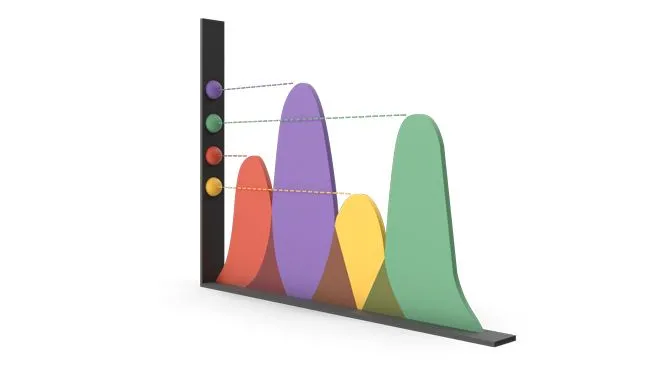The contact centre industry is driven by customer experiences that are easy, difficult, joyful, stressful and everything in between. It’s incredibly important to take these everyday interactions from associates and customers and quantify them in a tangible way.
Customer Satisfaction (CSAT), Customer Effort Score (CES), and Net Promoter Score (NPS) metrics have long been invaluable tools in the industry, but it’s critical to recognise that these metrics on their own cannot improve customer experience. Metrics only provide a superficial preview into the relationship between customers and associates, with the scores only reflecting a person’s feelings on a single interaction and not the brand.
Here is a quick dive into each metric and how CX leaders can take actionable steps to improve customer interactions.
What is a CSAT rating?
CSAT is a simple customer satisfaction survey methodology that measures a customer's satisfaction with an organisation. It's calculated by asking questions about the customer's experience, which is formatted into a survey scale that can range from 1-3, 1-5, or 1-10.
On the surface this covers the base experience between a customer and associate; users with a bad experience may show their dissatisfaction with a low score and a typical conversation may end with a quick perfect score. But this gets to heart of the issue with metrics, often the survey is quickly filled out to end the conversation.
How to improve CSAT
It’s critical not to focus solely on individual interactions. A great customer experience is made up of multiple interactions, across multiple channels.
Consider the myriad interactions a customer has with a company’s employees and other touchpoints. Defining the right set of metrics to gauge customer experience success requires mapping all points of contact, applying several customer experience metrics, and integrating customer interactions.
Voice of the customer (VOC) solutions can integrate most customer feedback: from voice recordings, chats, emails, agent notes, digital footprint, social commentary, and surveys to their shopping behavior and characteristics. Contact centres can then use the insights gathered through VOC solutions to improve customer experience, continually optimise product development, uncover new areas to automate, and deliver superior self-serve experiences that eliminate common friction points.
What is a CES rating?
CES is a customer satisfaction metric used to measure the ease of a customer's experience by asking them on a five-point scale, from "Very Difficult" to "Very Easy," to describe the effort required to use a product or service with a brand.
An issue with this scoring system is that it may only capture a customer experience “in the moment.” By this we mean that a CES rating might solely reflect a conversation between a customer and associate, not the experiences that occurred before or after.
How to improve CES
CX leaders need to understand the context behind customer interactions. Ask yourself, are you making it easier for customers to answer high-effort questions? Is technology only being introduced because it’s flashy or does it serve a purpose? And are there other ways to communicate with the customer that are less intrusive but helpful in creating a sticky customer relationship?
Be agile when uncovering reasons for customer churn. If a customer wants to end a service without speaking to an associate, instead of forcing a conversation, have them fill out a short exit survey. Do not let any interaction go untouched.
What is an NPS rating?
NPS evaluates customer experience and helps predict areas of growth. It’s a customer loyalty and satisfaction metric, ranging from -100 to 100, that measures how likely customers are to recommend a product or service to others. NPS has become a standard in measuring customer experience management programs and is key to identifying current sentiment and future behavior.
A negative aspect of NPS scoring is the sheer volume of NPS surveys. Customers can quickly become overwhelmed with NPS questions that take place after every phone call, chat, message, sales interaction, and more. All this at once can make a powerful metric quickly lose its value.
How to improve NPS
Open-ended questions can reveal amazing insight. But when reviewed manually, open-ended questions can be difficult and time-consuming to analyse. That’s where speech analytics software comes in. Advancements in this software can review and analyse freeform answers with scale and speed by identifying key words that signal great experiences to bad experiences, and a wide range in between. Identifying phrases and trends in past conversations can drive future interactions that take “what works” and foster excellent customer and employee experiences.
Act on CX findings
In addition to optimising your metrics, when you uncover insight and feedback, act. If customers know that an organisation will act based on their feedback, they are more likely to provide accurate responses. It’s better not to ask anything at all if you’re not going to act on the feedback.
Continual improvement can be achieved by implementing a constant feedback loop, linking survey responses (both qualitative and quantitative) to their respective outcomes. In doing this, you can edit/remove the questions that don’t yield the needed predictive insight, modify questions that are only slightly predictive, and add/test new questions to measure their possible predictive power.
CSAT, CES, and NPS can unlock impactful insight into an ecosystem of conversations across channels. It’s time for CX leaders to deploy these metrics with action, technology, and deep questions that consider the emotions behind customer service.
Learn more about contact centre metrics today
Contact Centre Analytics Solutions: Six Ways Analytics Impact Business Outcomes: It’s time to get a full view of the customer journey. Learn how to today!
Making the Last Mile Count: Discover how a hyper-growth food delivery company fostered amazing customer experiences with proactive insights.
Conversational Messaging: Why Customers Demand it (and How to Deliver it): Meeting customers on the channels they desire can help boost satisfaction and future loyalty.
Specialised Assistance Streamlines Collections Operations: Learn how a global telecommunication collection team provided empathy and much needed support to customers in need.
Travel Offshore, Beat NPS Goals: In the travel industry, customer loyalty is everything. Learn how TTEC helped employees deliver memorable experiences.
















